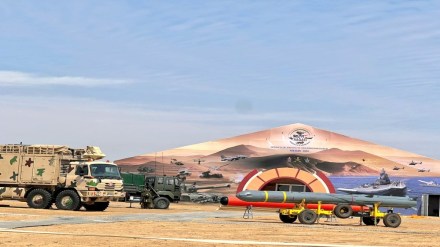Amidst the arid expanse of Rajasthan’s Pokhran, Prime Minister Narendra Modi bore witness to the 50-minute-long integrated tri-service firepower and manoeuvre exercise dubbed “Bharat Shakti.”
Accompanied by the country’s top military brass, the event served as a platform to spotlight India’s burgeoning self-reliance in defence, as the three services showcased the prowess of indigenously manufactured equipment.
From the sleek Light Combat Aircraft Tejas to the formidable T90 tanks, the demonstration underscored India’s growing emphasis on bolstering its defence capabilities through domestic innovation. With live firepower displays and strategic manoeuvres, the exercise aimed to exhibit the tri-services’ operational readiness in countering any threat while leveraging indigenous prowess.
Also, Advanced Light Helicopter (ALH) Mk-IV, Light Combat Helicopter `Prachand’, mobile anti-drone system, BMP-II and its variants, NAMICA (Nag Missile Carrier), T90 tanks, Dhanush, K9 Vajra and Pinaka rockets were among the platforms that demonstrated at Pokhran, about 100 km from Jaisalmer city.
Briefing media persons in New Delhi ahead of the mega drill –‘Bharat Shakti’ Additional Director General, Army Design Bureau, Major General C S Mann had said during the drill: “shock and awe” impact will be showcased that the armed forces seek to achieve in an operational situation with manoeuvre and fighting capabilities.”
And “Synergised joint operations will be decisive in the Indian context. Through live firepower and manoeuvre demonstration, it is endeavoured to showcase the tri-services operational capabilities to counter any threat leveraging indigenous capability and the ability to undertake conflicts in the face of global upheavals,” Major General Mann said on Saturday.
According to sources in the defence and security establishment, the first-of-its-kind exercise on such a scale is “not tailored towards any direction (northern or western border) or any adversaries”.
A statement issued by the Prime Minister’s Office, on Sunday, stated PM Modi will witness the ‘Bharat Shakti’ exercise at Pokhran.
“In a clear indication of India’s readiness to confront and overcome contemporary and future challenges with home-grown solutions, ‘Bharat Shakti’ highlights resilience, innovation and strength of India’s domestic defence capabilities on the global stage,” it said.
The exercise at Pokhran in Jaisalmer district also showcased systems and platforms integrated with the use of artificial intelligence (AI).
Also live integrated multi-domain operations of the three services in offensive operations using indigenous equipment, and “high synergy, multi-service, multi-domain capability, were demonstrating inter-service synergy.
The exercise, being conducted at Pokhran, imposes terrain restrictions on depicting naval manoeuvres. However, such equipment was showcased as part of the static display that followed the live demonstration.
Today’s proceedings commenced with the Army’s Special Forces, MARCOS of the Indian Navy and GARUDS of the Indian Air Force “infiltrating by all-terrain vehicles and slithering operations, while surveillance of the battlefield were carried out by remotely piloted aircraft and drones. This was followed by the degradation of targets by long-range vectors and artillery guns.
The IAF achieved a “favourable air situation by engaging strategic targets in depth, and the Indian Navy undertook maritime operations for strategic effects.
Some parts of the navy — like actions at sea were shown virtually on a screen. Besides firepower and ammunition, logistic capabilities for transporting equipment and evacuation of injured and casualties using the latest technologies were demonstrated.
Different types of Radars, UAV-launched precision-guided munitions, Quick Reaction Fighting Vehicles, drones of various types, including logistic drones and swarms of drones, and 3D-printed bunkers were all part of the massive drill today.
The aspects of India’s cyber and multi-domain operations capabilities were displayed along with the operations of the three services. How individual communication systems of the tri-services are integrated, ‘e-Tarang’ software tool, GIS-related systems, topographical maps, hydrographic charts and air navigation charts with analysis and operational planning capabilities will also be showcased during the exercise.
